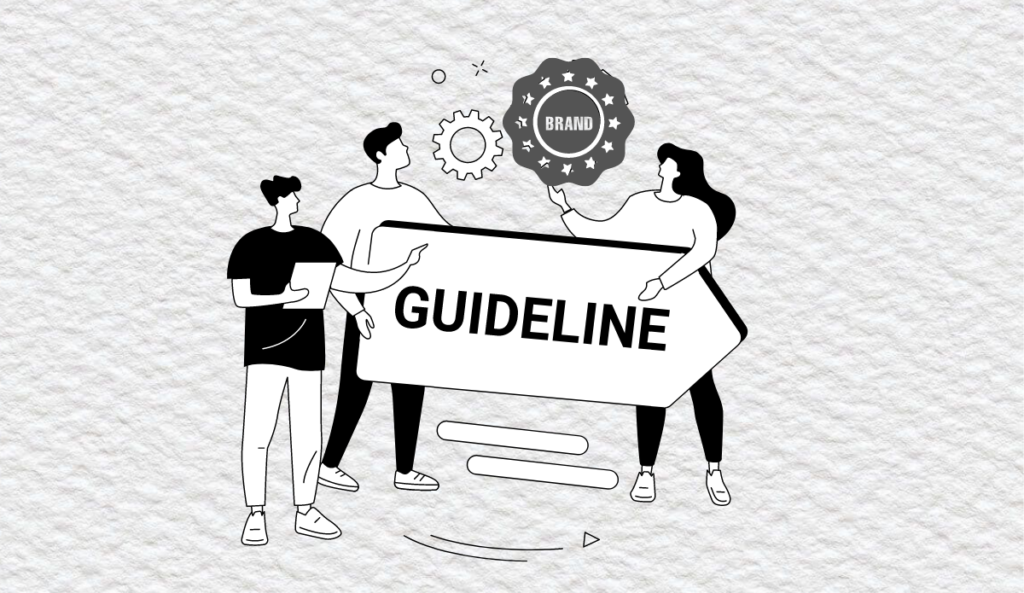
components of Brand Guidelines: Brand Guidelines are a crucial component of any successful branding strategy.
They are a set of rules and guidelines that dictate how a brand should be represented across all channels and platforms. They ensure that every communication, visual element, and marketing message aligns with the brand’s identity, values, and objectives.
In this article, we will discuss the nine important components of brand guidelines that you should consider when creating your own.

Components of Brand Guidelines: Color Palette
Color is an essential component of any brand’s visual identity. Your color palette should be consistent across all communication channels, including your website, social media, and printed materials. Your brand guideline should specify your primary and secondary color palettes, as well as any accent colors, and provide specific color codes for each hue.
Logo Usage
Your brand logo is the most recognizable visual representation of your brand. Your components of Brand Guidelines should outline how your logo should be used, including size, placement, and color variations. Additionally, your brand guideline should provide specific instructions for how your logo should not be used.
Correct and Incorrect Uses
Your brand guideline should also provide examples of correct and incorrect logo usage, typography, and color palette. These examples will help ensure that anyone who uses your brand assets is doing so correctly, and in a way that aligns with your brand’s identity.
Social Media
Social media is a crucial component of modern marketing, and components of Brand Guidelines should include specific instructions for how your brand should be represented on social media platforms. These instructions should include the use of your logo, color palette, tone of voice, and any specific guidelines for creating content on each platform.
Brand Assets
Your brand guidelines should include a list of all brand assets, including your logo, typography, color palette, and imagery. Additionally, your brand guidelines should specify how these assets should be used and provide access to any necessary files and templates.
Typography
Typography is an often-overlooked component of brand identity, but it plays a significant role in establishing a brand’s visual identity. Your brand guidelines should specify the typefaces and font styles that should be used in all communications, as well as any guidelines for typography hierarchy.
Imagery
Your brand guidelines should also specify the types of imagery that should be used in all communications, including photographs, illustrations, and graphics. Additionally, your brand guidelines should outline any specific guidelines for image style, color, and tone.
Voice and Tone
Your brand’s voice and tone are important components of your brand’s identity. Your brand guidelines should specify the tone of voice that should be used in all communications, as well as any specific guidelines for creating content that aligns with your brand’s values.
Printing Information
Your brand guidelines should also include instructions for how to print and reproduce any printed materials, including business cards, letterheads, and brochures. These instructions should include specific guidelines for color and font usage, as well as any specifications for paper stock and printing methods.
FAQs:
Q. Why are brand guidelines important?
A. Brand guidelines are important because they ensure that every communication, visual element, and marketing message aligns with the brand’s identity, values, and objectives. They help to establish consistency and credibility, which is crucial for building brand recognition and trust.
Q. How often should brand guidelines be updated?
A. Brand guidelines should be reviewed and updated periodically to reflect changes in your brand’s identity, values, and objectives. They should also be updated to reflect changes in communication channels and technology, such as social media platforms and website design.
Q. Who should have access to brand guidelines?
A. Anyone who is responsible for creating and sharing communications and marketing materials should have access to brand guidelines. This includes employees, contractors, and any third-party vendors who are working on behalf of the brand. By providing access to brand guidelines, you can ensure that everyone who represents your brand is doing so in a consistent and effective way.
Q. Can brand guidelines be customized for specific campaigns?
A. Yes, brand guidelines can be customized for specific campaigns or initiatives. However, any customization should still align with the overall brand identity and values. When creating customized brand guidelines, it’s important to consider the specific objectives and target audience of the campaign.
Q. What happens if someone doesn’t follow the brand guidelines?
A. If someone doesn’t follow the brand guidelines, it can result in inconsistency and confusion for the audience. This can undermine the credibility and effectiveness of your branding efforts. It’s important to educate and train anyone who is responsible for creating or sharing communications and marketing materials on the importance of following brand guidelines. Additionally, you may need to establish consequences for non-compliance in order to ensure that everyone takes brand guidelines seriously.
Conclusion
In conclusion, brand guidelines are essential for any successful branding strategy. By providing clear instructions and guidelines for every communication, visual element, and marketing message, brand guidelines ensure that every aspect of your brand aligns with your identity, values, and objectives.
The nine components of brand guidelines discussed in this article, including color palette, logo usage, social media, brand assets, typography, imagery, voice and tone, and printing information, provide a comprehensive framework for creating effective brand guidelines.
By implementing these components in your own brand guidelines, you can establish consistency and credibility, build brand recognition and trust, and ultimately achieve your branding objectives.





